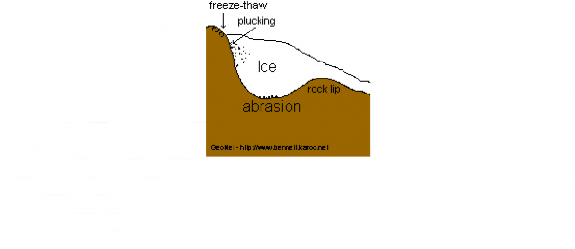Emergent lowland coast
A moving mass of ice and snow is called a glacier. Glaciers are formed when there is net year to year accumulation of snow, that is, when the amount of snow that falls in winter is greater than the amount that melts away in summer. Snow keeps on accumulating in layers one above the other. Its overlying pressure is applied to the underlying snow. It is so great that snow in lower layers becomes granular, hard and compact. The pressure also quickens the melting of some of the snow, which on refreezing starts turning into a granular ice. Again it is the pressure of the overlying layers which makes this solid mass of ice mobile. Thus glacier is formed through the processes of accumulation, compaction and recrystallisation of snow.
The movement of glacier is very slow and it moves from a few centimetres to a few metres in a day.
9.1. Action of Glacier

Plucking is when melt water from a glacier freezes around lumps of cracked and broken rock. When the ice moves downhill, rock is plucked from the back wall. Abrasion is when rock frozen to the base and the back of the glacier scrapes the bed rock. Freeze-thaw is when melt water or rain gets into cracks in the bed rock, usually the back wall. At night the water freezes, expands and causes the crack to get larger. Eventually the rock will break away.
There are three main types of glacial erosion - plucking, abrasion and freeze thaw.
